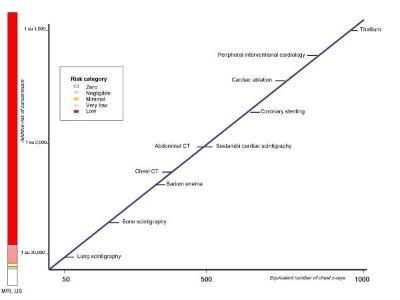Putting doses into perspective and minimising your risk
Radiation fact sheets and further information
The Irish population is exposed to radiation from several sources which are present either naturally in the environment or have been produced artificially by man. By far the biggest proportion of our radiation exposure comes from natural sources, particularly radon. Other natural sources include cosmic radiation from outer space, radioactivity in the food and water we eat and drink, and radiation from the ground. The beneficial use of radiation in medicine is the principal source of artificial radiation to which we are exposed (diagnostic X-rays, radiotherapy for cancer treatment, etc.).
A very high dose of ionising radiation over a short period of time to the whole body can cause death within a period of days or weeks. If the same dose were received over a limited part of the body, it might not prove fatal but other early effects could occur. If the same dose were received over a prolonged period – weeks or months - there would be more opportunity for the body to repair itself and there may be no early signs of injury. However, late effects could occur from the damage to the tissue which may only become apparent later in life, or in the person’s descendants. The most important of these late effects is cancer.
In Ireland, there is little risk of exposure to doses likely to cause early effects, and most people will be more concerned about the risks associated with low doses of radiation and the long-term effects of these doses. Although the cause of most cancers is not completely understood, exposure to agents such as tobacco smoke, asbestos and radiation are known to induce them. Radiation may induce cancer by causing mutations in DNA. These mutations allow a cell in normal tissue to begin abnormal growth that can sometimes lead to a malignancy. There can be a prolonged gap between the initial biological damage caused by ionising radiation and the appearance of clinical symptoms. This can range from several years up to 40-plus years.
The risk from exposure to ionising radiation is determined by calculating the effective dose (commonly shortened to dose) that takes into account:
The effective dose (or dose) is expressed in a unit called the sievert, which is abbreviated by the symbol Sv.
The sievert is a large unit: doses in Sv result in early effects. For most situations and when considering late effects, it is more usual to measure radiation doses received by people in millisieverts (mSv) or microsiverts (μSv). Millisieverts are one thousandth of a sievert and microsieverts are a millionth of a sievert.
The effects of high and very high doses of radiation have been well measured in scientific studies and scientists know fairly accurately the risk of a fatal cancer at this end of the scale.
At lower doses, the risk of fatal cancer is not precisely known, but it is assumed that there is a direct relationship between dose and risk all the way down to zero. That means at zero dose there is zero risk of harm, and at around 6 Sv to the whole body death is almost certain. A straight line between the two points gives the relationship between dose and risk.

In simple terms, a small dose carries a small risk, a medium dose carries a medium risk, and a high dose carries a high risk.
Based on the direct relationship between dose and risk, we can estimate that a dose of 10 μSv may increase the lifetime risk of fatal cancer by about 1 in 2 million. This compares with the existing lifetime risk of fatal cancer of approximately 1 in 4. This means that in a population of four million, one million can be expected to eventually die of cancer. If all four million people were exposed to an additional 10 μSv of ionising radiation, an additional 2 cancer deaths could be expected.
The following list gives the radiation doses commonly received every year by the average person in Ireland. Also given, at certain doses, is the lifetime risk of a fatal cancer.
The effects of doses at and above 1,000,000 μSv (1 Sv) received over a short period are given below to illustrate when immediate harm to the body is evident.
Radon is the largest source of radiation to which most Irish people are exposed, and it is one of the sources that is most readily controlled. You can minimise the health risk from radon gas, by testing your building and, if necessary, reducing its levels in your home. There is a legal obligation on employers in certain workplaces to test and if necessary, reduce radon levels.
The EPA regulates the use of artificial radiation in certain workplaces to minimise the risk to workers and the public.
Here you will find our fact sheets which will help you to understand more about radiation and its role in our lives. We have tried to provide you with the information you might require and to explore some of the issues around ionising radiation.